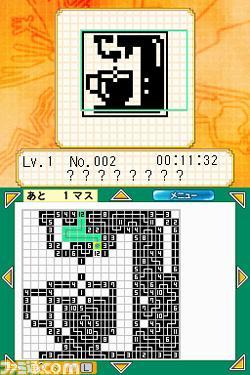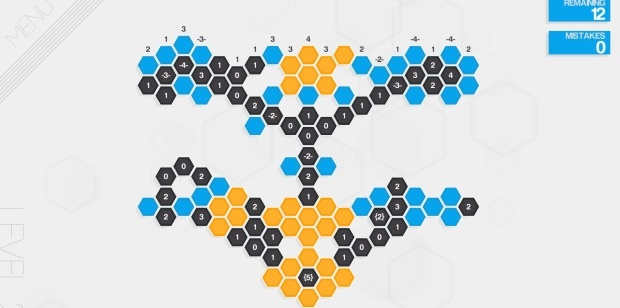Of course I finally get around to playing more puzzle games right around the time of forum transition. The Pagoda might be closed but rambling about puzzle games is forever!

Pic Pic is a collection of three different kinds of grid-based numerical/logic puzzles with four hundred entries each; we will be ignoring two of them, one because it is boring and the other because I can’t figure out how it works (reading japanese would likely help). The important one is Drawing. As in the aforementioned Slitherlink you are given a vast grid with certain boxes containing a number, except that instead of being limited to between zero and three they can reach into the twenties.
The idea is to connect two like numbers in a line that is made up of the same number of grid squares as said number. A “1” is just filled in by its lonesome, a “2” is always next to another one… err, “2”, and beyond that is where things get tricky. Starting with "3"s there are at least a couple different ways in which to connect them based on their location respective to each other, and the number of theoretical arrangements increases dramatically as the numbers themselves climb higher. Add in that there are often multiples of each number clustered near each other, requiring the player to determine which ones are paired together, and the potential complexity becomes obvious. When the grid is filled in correctly it forms a picture; one puzzle around the midpoint was the Mona Lisa while one of the very last ones was of a giant space turtle with some elephants on its back supporting a disc-shaped world. I liked that one the best.
There are a couple things to help guide the player. One is that each set of puzzles (they are grouped in five different sets based on size and difficulty) has both black & white and color ones. In the color ones there are several different colors that the numbers come in, with numbers of a given color only able to be connected to numbers of the same one. The other is that there is only one possible solution to each puzzle, and that knowledge can be used to the player’s advantage. If there are two possible arrangements between two numbers in a given situation, the player can see if one of them has no effect on the rest of the puzzle in terms of limiting options. If it has no effect while the alternative does, then as counterintuitive as it seems the one that limits options must be correct as otherwise there would be two possible correct arrangements.
It is worth noting that these puzzles become truly massive in scope. I loaded up puzzle #400 and it takes place on a grid 90 squares wide and 45 squares high. That’s 4,050 total squares according to my calculator. Slitherlink’s 36x20 grids were the largest I had come across previously; these are about five and a half times larger and can be overwhelming at times. To give a rough estimate of the time it takes to complete these puzzles I consider myself to have gotten pretty good at them by the end and the final ones were taking me in the area of thirty minutes to fill in. Before that I’d say most were finished in the ten to twenty minute range. One time I multiplied that by four hundred and asked questions of myself.
In terms of how it actually plays, after a quick once over filling in all the gimme squares to start it becomes a game of picking a section of the grid, visualizing all the various line arrangements possible and logically trying to determine which ones are even possible and if there is more than one which is most likely. Sometimes one is lucky and they can solve an entire section on the first go but usually there is not enough information and they have to look elsewhere for a while. In the color puzzles in particular the majority of squares will be filled in (unless the final image has a lot of negative space; these are often the hardest to solve) so solving a given section of the grid has the effect of producing more info with regards to solving adjacent ones. In this way you often get a cascade effect where after an extended run of little progress you will solve a bit that lets you solve an adjacent one, the result being a wave of progress across the entire grid. It ultimately lacks the… elegance of Picross and the aforementioned Slitherlink, the two kings of this particular logic game subgenre, but Pic Pic is a more than worthy entry on the level right below those two giants.
I recall seeing a few games like this available on various android or app stores. I did not get a chance to play any of them but they seemed to be a good bit smaller in scope. Still given the relative ease of access they may be worth investigating.








